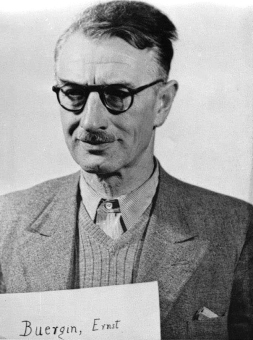Ernst Bürgin (1885–1966)

© National Archives, Washington, DC
“Personally, I had no reason to join [the NSDAP]; but in order to prevent that there be any wedge driven in between the workers and the leaders of the plant by the Party, I accepted the invitation to join the Party. After all, this didn’t mean any change in prayer books, and I didn’t do anything different after I was changed from a member of the people to a member of the Party (vom Volksgenossen zumParteigenossen).”[1]
Ernst Bürgin was born in Wyhlen on July 31, 1885. After his school years in Basel, he studied chemistry in Basel and then in Berlin, where he received his Ph.D. in 1911, writing a dissertation under Walther Nernst on “Contributions to the Knowledge of the Formation of Perborates by Means of Electrolysis.” In 1912, he did his military service as a one-year volunteer in the 9th Schleswig-Holstein Foot Artillery Regiment. From 1913 onward, he worked as an experimental chemist for Landshof & Meyer in Berlin, focusing on the field of electrochemistry.
During World War I, Ernst Bürgin served for four years on various fronts; back from the war, he spent the next two years unemployed. In 1920, he got a job as an electrochemist at the Rheinfelden plant of the chemical company Griesheim-Elektron, and rose to become an authorized signatory and the manager of this plant in 1924. He married Hildegard Fechtig in 1922, and the couple had four children.
In 1931, Ernst Bürgin became the manager of the Bitterfeld-Süd plant; in 1933, he was promoted to director; and in 1938, he was named head of I.G. Farben’s operating unit in central Germany (Betriebsgemeinschaft Mitteldeutschland). From 1936 on, he assisted Carl Krauch with statistical data for the Four Year Plan. He joined the NSDAP in 1937, and one year later he became a full member of the I.G. Farben managing board. Here he was a member of the Technical Committee and the Chemical Committee. In 1941, he received the War Merit Cross (Kriegsverdienstkreuz) Second Class, followed two years later by the War Merit Cross First Class. In addition, he was named a “military economy leader” (Wehrwirtschaftsführer) in 1942, and was a member of the Economic Group Chemistry (Wirtschaftsgruppe Chemie).
In June 1947, Ernst Bürgin was arrested by the U.S. Army and indicted in the I.G. Farben Trial at Nuremberg. The next year, the court sentenced him to two years in prison for “plundering and spoliation,” in particular for his responsibility for exploitation of Norwegian aluminum projects to produce light metal for the German Luftwaffe.
Part of his papers are in the archives of the Fritz Bauer Institute, available for use in academic research.
(SP; transl. KL)
















